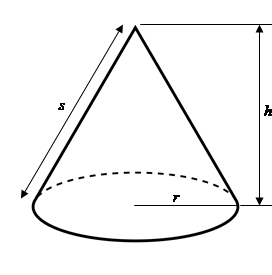Solid Geometry
Sphere
A sphere is a perfectly symmetrical solid with all points on the surface at the same distance $r$ from the centre. It has no edges or corners.
Surface area of sphere $=4\pi r^2$
Volume of sphere $=\frac43 \pi r^3$

Cylinder
A cylinder has a flat circular base and top which both have the same radius, $r$. It has one curved side with height $h$.
Surface area of cylinder $=2\pi r(r+h)$
Volume of cylinder $=\pi r^2h$

Cone
A cone has a flat circular base with radius $r$. It has one curved side. The point at the top of the cone is called the apex. It has a height $h$ and side length $s$. Note that the side length is only defined if the cone is a right circular cone, that is the apex is directly above the centre of the base.
Surface area of cone $=\pi r(r+s)$
Volume of cone $=\frac13 \pi r^2h$

Triangular and square pyramids
A triangular pyramid has four triangular faces with three side faces and one base. It has four corner points (vertices) and six edges.
A square pyramid has five faces. The four side faces are triangles while the base is a square. It has five vertices and eight edges.
The formula for the surface area and the volume is the same for both triangular and square pyramids, although the formula for the [Base area] will be different for each.
Surface area $=$ [Base area] $+\frac12\times$ perimeter $\times$ [slant height]
Volume $=\frac13\times$ [Base area] $\times$ height

Note: When side faces are different sizes we can calculate the area of the base and each triangular face separately and then add them up to find the total surface area.
Additional Resources
- Common 3D Shapes - a useful pictorial reference of commonly occurring 3D shapes.
- Solid Geometry - the Khan Academy's collection of videos covering volumes of solids.
- Surface Areas of 3D Figures - a Udemy video showing how to calculate the surface areas of a variety of figures.
Mobile options:

